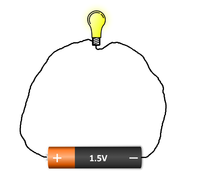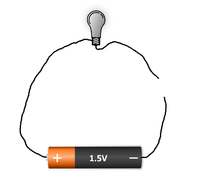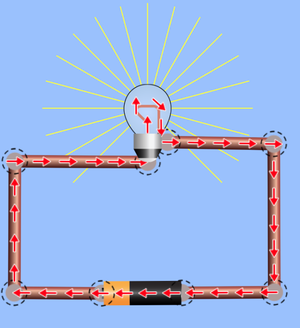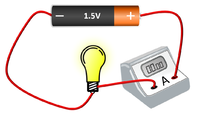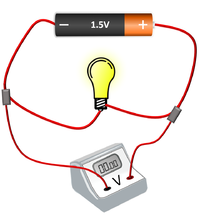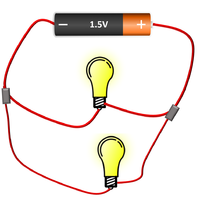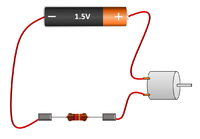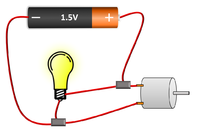Difference between revisions of "Circuit"
| Line 30: | Line 30: | ||
: [[Component]]s in [[Parallel Circuit|parallel]] in a [[circuit]] have the same [[Potential Difference]] across them but share the [[Electrical Current|Current]]. | : [[Component]]s in [[Parallel Circuit|parallel]] in a [[circuit]] have the same [[Potential Difference]] across them but share the [[Electrical Current|Current]]. | ||
: [[Component]]s in [[Series Circuit|series]] in a [[circuit]] have the same [[Electrical Current|Current]] through them but share the [[Potential Difference]]. | : [[Component]]s in [[Series Circuit|series]] in a [[circuit]] have the same [[Electrical Current|Current]] through them but share the [[Potential Difference]]. | ||
| + | |||
| + | ===Examples=== | ||
| + | {| class="wikitable" | ||
| + | |- | ||
| + | |[[File:CircuitCellBulbAmmeterSeries.png|center|200px]] | ||
| + | |[[File:CircuitCellBulbVoltmeterParallel.png|center|200px]] | ||
| + | |[[File:CircuitCellBulbBulbParallel.png|center|200px]] | ||
| + | |- | ||
| + | | style="height:20px; width:200px; text-align:center;" |The [[Electrical Bulb|bulb]] and [[Ammeter]] are in [[Series Circuit|series]] so they have the same [[Electrical Current|Current]] going through them. | ||
| + | | style="height:20px; width:200px; text-align:center;" |The [[Electrical Cell|cell]], [[Electrical Bulb|bulb]] and [[Voltmeter]] are in [[Parallel Circuit|parallel]] so they have the same [[Potential Difference]] across them. | ||
| + | | style="height:20px; width:200px; text-align:center;" |The two [[Electrical Bulb|bulbs]] are in [[Parallel Circuit|parallel]] so they have the same [[Potential Difference]] across them but may have a different [[Electrical Current|Current]] passing through them. | ||
| + | |- | ||
| + | |[[File:CircuitCellMotorResistorSeries.png|center|200px]] | ||
| + | |[[File:CircuitCellMotorBulbParallel.png|center|200px]] | ||
| + | |[[File:CirctuiCellResistorMotorBulb.png|center|200px]] | ||
| + | |- | ||
| + | | style="height:20px; width:200px; text-align:center;" |The [[motor]] and [[resistor]] are in [[Series Circuit|series]] so they have the same [[Electrical Current|Current]] passing through them but share the 1.5[[V]] [[Potential Difference]] between them. | ||
| + | | style="height:20px; width:200px; text-align:center;" |The [[Electrical Bulb|bulb]] and [[motor]] are in [[Parallel Circuit|parallel]] so they have the same [[Potential Difference]] across them but may have a different [[Electrical Current|Current]] passing through them. | ||
| + | | style="height:20px; width:200px; text-align:center;" |The [[motor]], [[resistor]] and [[Electrical Bulb|bulb]] are in [[Series Circuit|series]] so they all have the same [[Electrical Current|Current]] passing through them but share the 1.5[[V]] [[Potential Difference]] between them. | ||
| + | |} | ||
===Energy Transfers=== | ===Energy Transfers=== | ||
Revision as of 11:36, 31 October 2018
Contents
Key Stage 2
Meaning
A circuit is a loop of wire that electricity flows around.
About Circuits
- A circuit needs to be complete otherwise electricity will not flow through it. Any break in the circuit will stop the electricity from flowing.
- A circuit starts and ends at the source of power. This is usually a battery or cell but it can be a generator or Solar Cell.
| A circuit must be a complete loop without any breaks or it will not work. | The break in this circuit stops it from working. |
To practice building a circuit you can use a circuit simulator by clicking on the picture below.
Key Stage 3
Meaning
A circuit is a loop of wire that electricity flows around.
About Circuits
- Circuits can have components in series or parallel.
- Components in parallel in a circuit have the same Potential Difference across them but share the Current.
- Components in series in a circuit have the same Current through them but share the Potential Difference.
Examples
| The bulb and Ammeter are in series so they have the same Current going through them. | The cell, bulb and Voltmeter are in parallel so they have the same Potential Difference across them. | The two bulbs are in parallel so they have the same Potential Difference across them but may have a different Current passing through them. |
| The motor and resistor are in series so they have the same Current passing through them but share the 1.5V Potential Difference between them. | The bulb and motor are in parallel so they have the same Potential Difference across them but may have a different Current passing through them. | The motor, resistor and bulb are in series so they all have the same Current passing through them but share the 1.5V Potential Difference between them. |
Energy Transfers
Cell
- Energy is transferred electrically out of the chemical potential energy store.
Light Bulb
- Energy is transferred electrically into the the thermal energy store of the bulb.
- Energy is also transferred away from the bulb by light radiation.
Motor
- Energy is transferred electrically into the the kinetic energy store of the motor as it speeds up.
- Energy is transferred electrically into the the thermal energy store of the motor due to friction.
Speaker or Buzzer
- Energy is transferred electrically into the the kinetic energy store of the Speaker.
- Energy is also transferred away from the Speaker by sound radiation.
